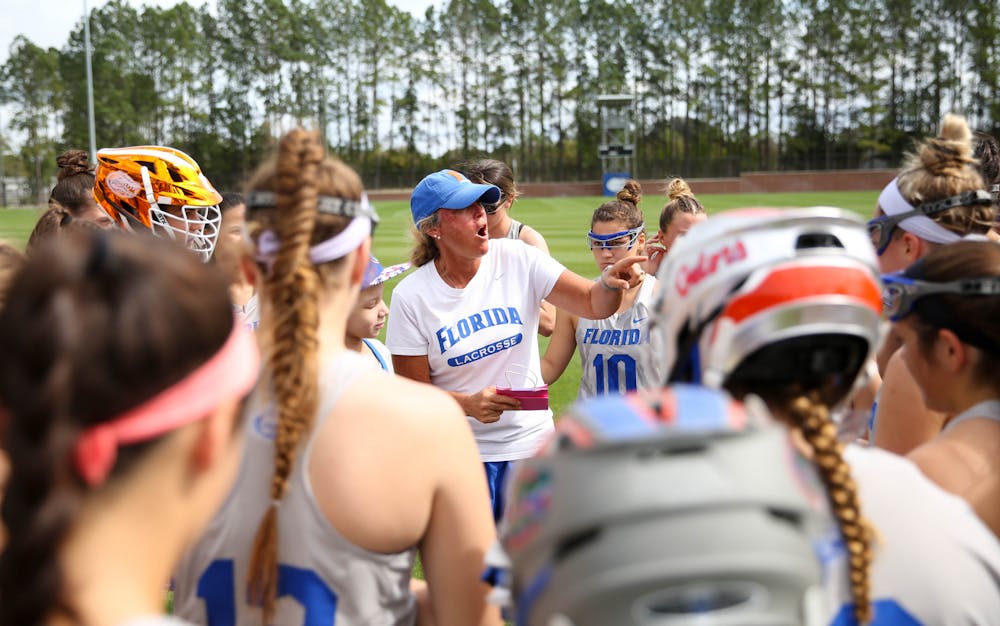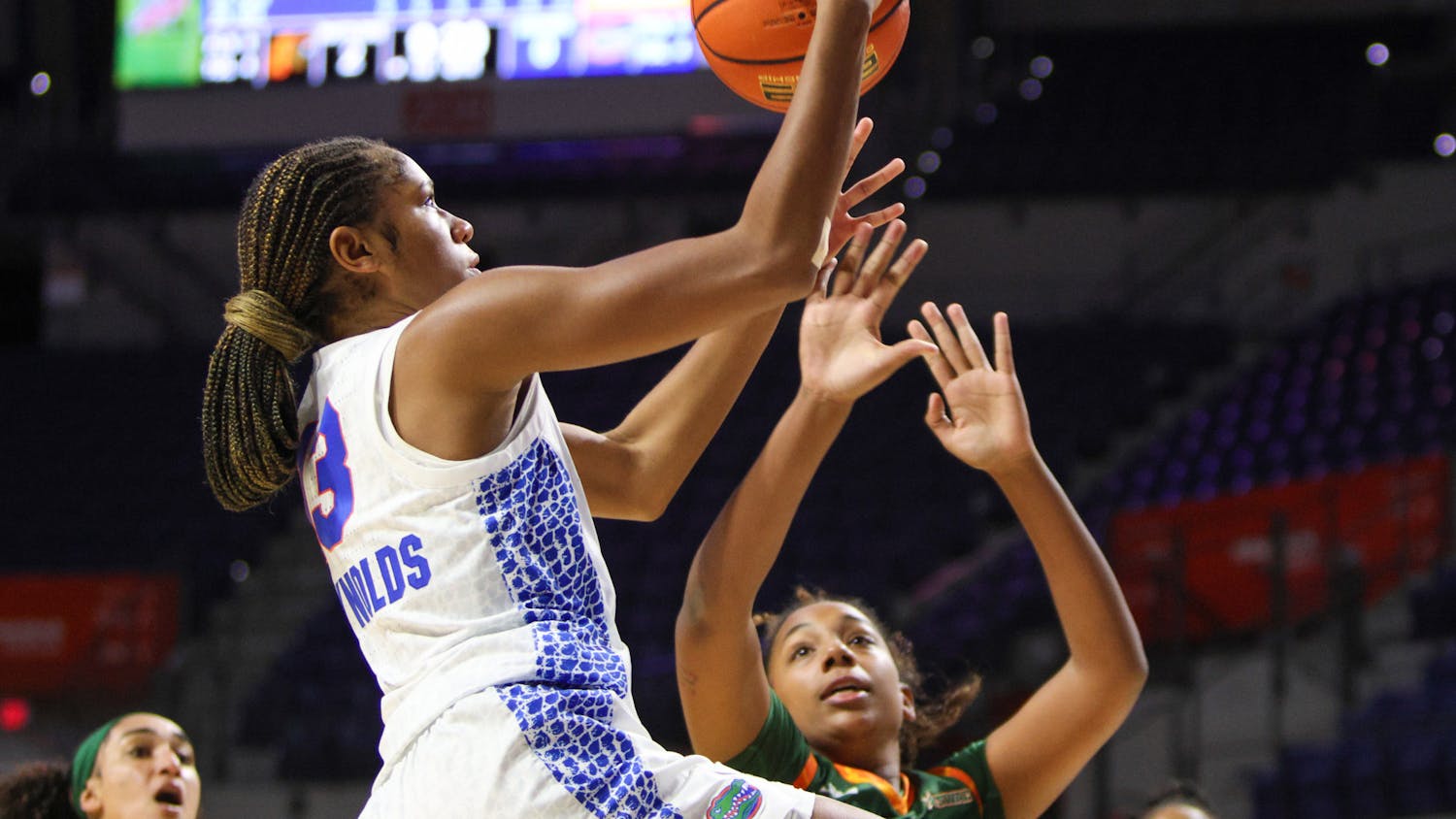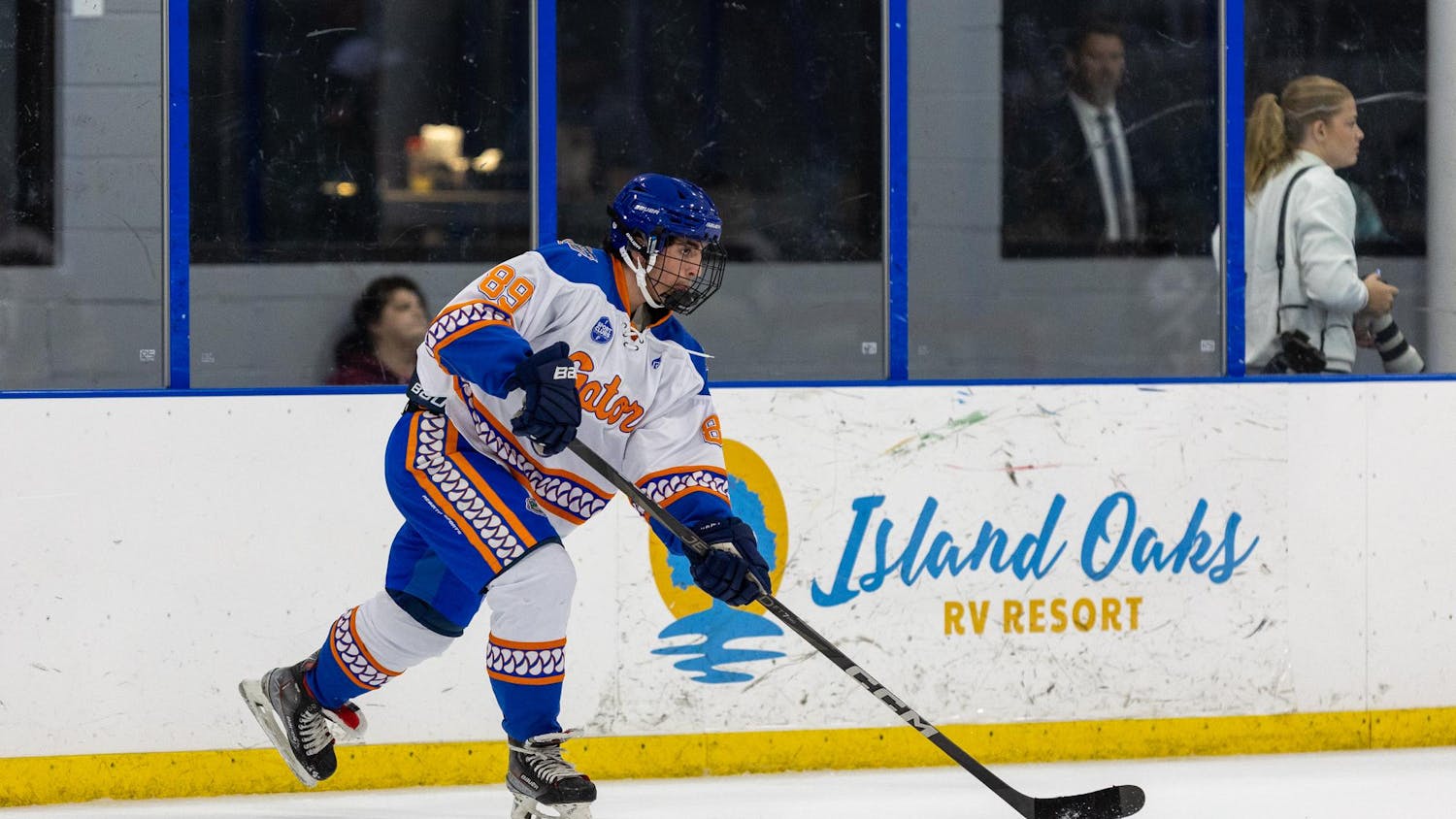Shannon Kavanagh and Kaitlyn Dabkowski rushed to the center of the field.
Both athletes were exhausted after beating Vanderbilt 22-9. Kavanagh scored seven times that afternoon. Dabkowski fortified a defense that didn’t allow the Commodores’ top scorers more than one goal.
Their legs felt like Jell-O. Sweat stained their foreheads and jerseys. But what stood at center field on that tepid April 18 afternoon rejuvenated the fatigued seniors.
So they ran, smiled and then, after some encouragement, Kavanagh hoisted the AAC regular-season championship trophy above her head as her teammates celebrated around her. Another moment of triumph for the lacrosse program still well within its adolescence.
In the back stood Amanda O’Leary. The architect of the adolescent program, she’s happy winning and happiest watching her team enjoy the euphoria of success.
That desire to bask in the warmth of success is part of what powered the Gators to 10 different regular-season championships and eight post-season titles. It’s what keeps her program as regular members of the nation’s top-25 teams each year.
But her competitive desire is just one piece of the Florida lacrosse puzzle, a fraction of why the program, in such a short amount of time and in a region far from the traditional talent hotbeds, is knocking on the door of a national championship.
It’s ‘Lacrosse,’ not ‘LaCrosse’
Jeremy Foley had a vision. The University of Florida’s athletic director from 1992 to 2016, he knew what it meant to do his job and do it well.
First and foremost, the Gators needed to win national championships. One could say he passed this goal with flying colors. Over the 24 years he orchestrated the University Athletics Association (UAA), his Gators won 24 national championships, not including individual national champions or all the conference championships.
But winning was only one part of Foley’s equation. He knew Florida had room to expand, and under his guidance, UAA hit its growth spurt.
First came soccer. Foley appointed Becky Burleigh as the program’s head coach in 1994 and, within four years, she guided the program to its first national championship.
In 1995, the UAA’s board of directors approved the program to foster another sport: softball. Larry Ray was hired as the program’s head coach that year and in 1997, the Gators played their first game.
Foley wasn’t done. For both sports, he monitored growing trends and modeled his vision of UAA to become more modern. When soccer’s popularity rose, the Gators had a team. When softball’s popularity grew, the Gators had a team.
But as lacrosse became the fastest growing sport in the United States, the Gators didn’t have a team.
Born in Washington D.C. and raised in New Hampshire, Foley grew up playing lacrosse. The sport was embedded in the northeast culture, and Foley loved the fast pace, the precision, the hard hits and electrifying goals. He eventually accepted an athletic scholarship to Hobart College, where he played both football and lacrosse.
When the idea came to bring lacrosse to UF, some made tongue-in-cheek comments that his motivation came from his past. But, until that point, Foley had never seen a women’s lacrosse game.
Not yet, at least.
The UAA decided to add a women’s lacrosse program in 2005, and in 2007, appointed Amanda O’Leary as the head coach.
“There's no athletic program in America that cares more about women's athletics than the University of Florida has throughout its history,” Foley said.
It was hard to find someone with a better resume than O’Leary.
As a player, O’Leary started all four years at Temple University from 1985 to 1988 and won a national championship as a senior. Then she and the United States Women’s National Lacrosse Team won the International Federation of Women's Lacrosse Association World Cup twice, once in 1989 and again in 1993.
O’Leary was inducted into the Temple Athletic Hall of Fame in 2004 and later the National Lacrosse Hall of Fame as a player and coach in 2005.
After stints as an assistant head coach at the Universities of Maryland and Delaware, Yale hired her as the program’s head coach in 1994. During 14 seasons, her Bulldogs compiled a 162-65 record.
Eventually, O’Leary wanted change. She adored Yale and the opportunities the school presented her and her family, yet, the extreme emphasis on academics above all else handcuffed her ability to recruit. The excitement of starting a new program in her desired image and likeness in the warm Florida sun was too much to pass, and O’Leary dove right in.
There were, however, some immediate challenges. For starters, there was nowhere to play or practice.
So after a $15 million bill, the Donald R. Dizney Stadium was constructed in 2008. The complex featured two fields, space for 1,500 fans and a 12,000 square-foot indoor facility housing locker rooms for the Gators lacrosse team, a visiting team, managers and coaches. The stadium featured a training room, an equipment room and a conference room.
It was the Taj Mahal of facilities.
But lacrosse, while popular nationally, was still merely budding in Florida. Jacksonville University was the only college in the state with an NCAA Division I program.
When O’Leary ordered shirts, the manufacturer sent them misspelled. They capitalized the ‘C’ in the sport’s title. With lacrosse still a relatively niche sport in the sunshine state, they thought the shirts were meant for the nearby city of LaCrosse.
The coach had the resume and knowledge to build a winning program, but success wasn’t guaranteed.
Finding a home
What defines a home?
Is it something that can be uprooted without repercussion?
Luring top talent who lived miles and miles away from Gainesville offered a hard task.
The home O’Leary had to offer them was one where alligators bask in the sun. A place where love bugs infest the summers and whose hot, humid weather through much of the year feels like walking through a mouth.
Only three of the 40 players currently on UF’s roster are from Florida. Of the rest of the team, 10 are from New York, 15 are from Maryland and most of the rest hail from other nooks and crannies in the northeastern United States.
Convincing them to uproot their lives, to leave friends and families, especially when local blue-chip programs hungrily recruit those same players, is tough.
So when she got the job, O’Leary immediately went to work.
“At that point, we were recruiting eighth-graders,” O’Leary said.
She sold recruits on dreams of glory and the prospects of turning a program with no history into something the nation shivers thinking about. She sold them on the warm weather — a stark contrast from the winter chill of the northeast. As it turns out, many of Florida’s players appreciated ditching their winter coats to soak up the warm rays of Gainesville’s sun.
Before she was a first-team All-American, Kitty Cullen was the second-ranked recruit in the country and received sales pitch after sales pitch before she could even drive a car. The Rockville, Maryland native was wooed by all the top schools, including Notre Dame, Maryland, UNC and Johns Hopkins. And, of course, there was Florida.
When she made her first visit. O’Leary didn’t have trophies to show off, or even a team for that matter. But she had a blueprint; a vision of something spectacular.
“She just laid it out there,” Cullen remembered.
She could either believe in the dream and share the architect’s confidence in immediate success, or not. If the latter were the case, the Gators weren’t the right fit. Cullen bought in.
O’Leary’s first recruiting class, Cullen included, was the nation’s best. Since Inside Lacrosse started keeping track of recruiting, Florida is the only program in the history of Division I women’s lacrosse to achieve a top-ranked recruiting class in the first season.
Backed by her reputation and prospective talent, talk grew of the start-up down south.
There were no veterans to lead the underclassmen. There were three upperclassmen on the team, all of which came from the UF club lacrosse team that had placed fourth in the 2009 Women’s Collegiate Lacrosse Association National Championship. Nobody had firsthand experience with the team and playing for O’Leary.
So O’Leary scheduled scrimmages in Maryland to acclimate her team. They shared team dinners, and it wasn’t uncommon to find a player or two at O’Leary’s home.
“We were just kind of in this crazy situation with no guidance,” Cullen said.
The initial shock forged the team’s chemistry. Their apprehension dwindled as the players found their footing on the team. They wanted to make their dream a reality.
On Feb. 20, 2010, at 6 p.m. beneath the Diz’s lights, the Gators hosted Jacksonville University for the first game in program history. In front of 2,114 fans, UF won 16-6.
“It's a testament to not only the University of Florida, but the community here in Gainesville,” O’Leary said after the game. “You can't ask for anything more, when you go out and that's your debut and you have that kind of support.”
The Gators finished the season 10-8, becoming just the sixth school in Division I women’s lacrosse history to earn at least 10 wins in its first season.
The Gators clinched their first conference championship a year later when they beat the No. 2 Northwestern Wildcats 13-11 on April 14, 2011, to win the American Lacrosse Conference. Florida finished their conference schedule a perfect 5-0 and qualified for the program’s first NCAA Tournament appearance.
Sustaining success
Sydney Pirreca’s first passion was gymnastics, but the sport quickly wore the midfielder, who played lacrosse at UF from 2016 to 2019, down. She would practice six days a week and went to the gym twice a day during summers. It consumed her life at a time when she wanted wiggle room for freedom.
So she took two weeks off. If she missed gymnastics, she would go back to the running, tumbling and jumping she grew familiar with.
“In those two weeks, I found the lacrosse stick in my hand and I never went back,” Pirreca said.
Lacrosse isn’t just a sport in Long Island where Pirreca is from. It’s woven into the island’s culture, and Pirreca slipped effortlessly into its grasp.
Her athleticism flourished on the field, and she relished the atmosphere which came with playing on a team. Gymnastics wasn’t exactly a team sport.
“I picked up the stick and I instantly fell in love with it,” Pirreca said with a subtle Long Island accent. “The team sport, the atmosphere, the fast play made me fall in love with the sport.”
Her excellence caught the attention of universities.
Pirreca’s sister, Shayna Pirreca, was a freshman at UF in 2015. Meanwhile, Pirreca was a senior at Mount Sinai High School in Long Island, New York and the No. 1 recruit in the country.
The younger Pirreca had already captured O’Leary’s attention when they met at an Under Armour tournament when Pirreca was a freshman at Mount Sinai. With her sister in Gainesville, Pirreca felt comfortable enough to travel 1,046 miles south to play college lacrosse.
“Mandee (O’Leary) does a really great job at showing that she wants you and making you feel like you’re important,” Pirreca said.
O’Leary drew recruits like moths to light in part because of her infectious personality. She sports a glowing smile and is rarely not laughing. She’s always available for players and encourages openness within her locker room. She knows what it’s like to be a little fish in a big pond and wants her players to feel at ease as they acclimate to living in a new city.
Her husband, Kevin O’Leary, believes her ability to read her student-athletes and pick players up when they’re down is one of the reasons why the Gators’ culture doesn’t exhibit any cracks in the foundation.
It’s not uncommon for her players to visit the O’Leary’s home or the team to regularly eat family dinners together.
All the closeness is magnified by her coaching.
Hall of Fame-caliber athletes seldom successfully transition to coaching. As they get better at what they do, it becomes harder to explain what needs to be done to become great because they perceive their sport faster and better than the average human. Explaining their knowledge to mortals can be like teaching English to a goldfish.
O’Leary is different.
“She's somebody who sits back and watches the game as it unfolds and knows the right buttons to push,” Kevin O’Leary said.
O’Leary adjusts practices as she sees fit. Student-athletes live rigorous lives. Sometimes, she has the Gators play any game that isn’t lacrosse. They used to play kickball, until starting goalie Cara Cannington broke her finger one fateful day. Between the fun comes, of course, practice. O’Leary conducts it like the New York Philharmonic Orchestra.
She breaks down her perception of her game into a whirlwind of drills and strategies in a way someone who doesn’t know a lacrosse stick from a broomstick could understand.
O’Leary and her husband regularly sit and watch recordings of games and practices together, breaking down the mundane aspects of the game to find flaws and figure out what’s succeeding.
Kevin O’Leary has years of experience with lacrosse. He was a goalie at Maryland University from 1981 to 1984, when his Terrapins made an NCAA Tournament Final Four appearance in 1983, and he later coached and refereed. Yet he is regularly amazed by his wife’s ability to decipher even the simplest of plays.
“She has a unique ability to understand (lacrosse) and that's why she's lasted as long as she had,” Kevin O’Leary said.
At Yale, Kevin O’Leary remembered watching her practices when she would push for perfecting the fundamentals above all else. He would sometimes suggest switching things up to focus on the offensive and defensive plays.
“She was just smart enough to know that she needed to stick to those fundamentals and go from there,” he said.
In O’Leary’s first season coaching at Yale, the team finished 10-5. Only once during her 14 years coaching in New Haven, Connecticut did one of her teams fail to win at least 10 games. They won nine in 2006.
In one of her first practices, Cullen — who, by the end of her collegiate career, would be named to 11 different All-American teams and earned two Tewaaraton Award nominations, college lacrosse’s equivalent of the Heisman Trophy — was told she didn’t catch and throw the ball correctly.
“They really, really pushed us,” Cullen remembered. “Mandee wanted to set the bar high. And she totally did and you know, (she) pushed us really to our breaking points at some times but it made us so much stronger and made us realize what we could do.”
For all the times she spent smiling and enjoying the fruits of her team’s labor, O’Leary is never afraid to flip the switch. She can’t forge a winning team with a hammer made of feathers. And year after year, despite the pressure, the team never cracked.
Brianna Harris, Shannon Kavanagh and Kaitlyn Dabkowski all share a connection. Yes, they’re currently teammates and are preparing for one more NCAA Tournament run. But on their bodies is a matching tattoo. A small wave etched on one of their fingers.
They gifted O’Leary a shirt with the phrase “ride the wave” and a surfer printed on it.
There will be ups, there will be downs, but losing the rhythm isn’t an option. That’s the spirit behind the tattoo and the way in which the team flows.
Since the program’s inception, O’Leary would repeatedly schedule games against blue-chip programs. She wanted to test her student-athletes against the nation’s best to serve as a barometer for how well the team plays and where it needs to improve.
“It really kept us humble,” Cullen said. “But it also kept us hungry for more.”
That hunger is the rest of the puzzle that O’Leary put together. It’s why the Gators qualified for every NCAA Tournament since 2011, and why they won eight of the last nine conference tournament championships.
It’s why, in a region unlike the others and in a town where football is held sacred, a college lacrosse team flourished in a swamp. It’s why the Gators are knocking on the door of a national championship.






